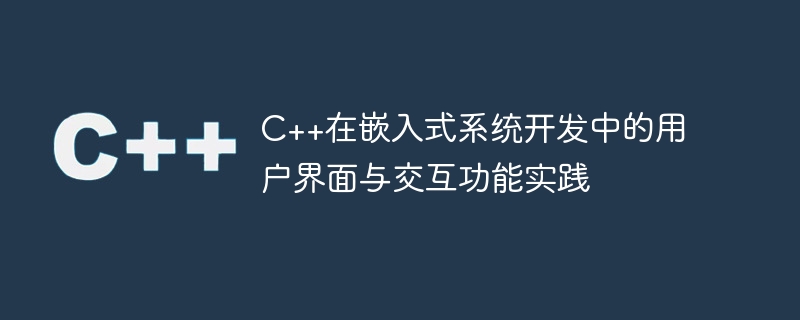

C User interface and interactive function practice in embedded system development
Embedded systems play an important role in modern life, from home appliances to cars, From smart watches to industrial controls, various embedded devices have requirements for user interface and interactive functions. As a widely used high-level programming language, C has flexibility, portability and performance advantages, and has become the preferred language in embedded system development. This article will introduce how to use C to implement user interface and interactive functions in embedded system development, and provide practical demonstrations through code examples.
1. User interface design
The user interface design of embedded systems should focus on user experience and usability, while taking into account the hardware resource limitations of the device. C provides a variety of interface design libraries and frameworks, such as Qt, wxWidgets, etc. Developers can choose the appropriate library for development according to project needs. The following takes Qt as an example to introduce how to use C to implement user interface design for embedded systems.
In Qt, the interface can be designed through the QML language. QML is a declarative language based on JavaScript that can easily describe the user interface and interaction logic. The following is a simple QML code example that implements a user interface containing text and buttons:
import QtQuick 2.0
Rectangle {
width: 200
height: 200
Text {
anchors.centerIn: parent
text: "Hello World"
font.pixelSize: 20
}
Button {
anchors.horizontalCenter: parent.horizontalCenter
anchors.bottom: parent.bottom
text: "Click Me"
onClicked: {
console.log("Button clicked")
}
}
}Through the above code, we define a rectangular control and place a text control in the center of the rectangle with text content For "Hello World", the font size is 20 pixels. At the same time, we place a button in the lower part of the rectangle, display "Click Me" on the button, and print log information when the button is clicked.
Through the above examples, we can see that using C language combined with QML can easily realize the design of user interface. You only need to describe the hierarchy, style, layout and interaction logic of the control in the QML file, and then Simply load this file into your application via C code.
2. Realization of interactive functions
In addition to user interface design, embedded systems also need to implement rich interactive functions. In C, various libraries and frameworks can be used to implement these functions, such as serial communication, network communication, sensor data collection, etc. Below, we will introduce how to use C to implement serial communication through a code example.
In embedded system development, serial communication is a common interaction method. C provides a variety of libraries for serial communication, such as Boost.Asio and Qt SerialPort. The following is a sample code that uses the Qt SerialPort library to implement serial port communication:
#include <QtSerialPort/QSerialPort>
#include <QCoreApplication>
#include <QDebug>
int main(int argc, char *argv[])
{
QCoreApplication a(argc, argv);
QSerialPort serial;
serial.setPortName("/dev/ttyUSB0");
serial.setBaudRate(QSerialPort::Baud9600);
serial.setDataBits(QSerialPort::Data8);
serial.setParity(QSerialPort::NoParity);
serial.setStopBits(QSerialPort::OneStop);
if (serial.open(QIODevice::ReadWrite)) {
qDebug() << "Serial port opened successfully";
qDebug() << "Sending data...";
serial.write("Hello World");
qDebug() << "Data sent";
serial.close();
} else {
qDebug() << "Failed to open serial port";
}
return a.exec();
}Through the above code, we create a QSerialPort object and set the parameters of the serial port, such as device name, baud rate, data bits, calibration check position and stop position. Then we try to open the serial port. If the opening is successful, we write a piece of data "Hello World" to the serial port, and then close the serial port. If the opening fails, an error message is printed.
Through the above examples, we can see that the serial port communication function can be easily implemented using C language combined with the Qt SerialPort library. You only need to set the serial port parameters and then call the corresponding function. Developers can implement other interactive functions in a similar manner based on specific project needs.
Summary:
This article introduces how to use C to implement user interface and interactive functions in embedded system development. By choosing appropriate interface design libraries and frameworks, developers can easily implement user interface design. At the same time, by leveraging various libraries and frameworks, such as the serial communication library, developers can implement rich interactive functions. As a flexible, portable and high-performance programming language, C has broad application prospects in embedded system development.
However, it should be noted that in actual development, developers need to carefully consider the hardware resource limitations and performance requirements of the embedded system, select appropriate libraries and frameworks, and conduct sufficient testing and optimization to Ensure system stability and reliability. I hope this article will be helpful to readers in using C to implement user interface and interactive functions in embedded system development.
The above is the detailed content of C++ user interface and interactive function practice in embedded system development. For more information, please follow other related articles on the PHP Chinese website!
 Is linux an embedded system?
Is linux an embedded system?
 What are the differences between c++ and c language
What are the differences between c++ and c language
 Recommended learning order for c++ and python
Recommended learning order for c++ and python
 Cost-effectiveness analysis of learning python and c++
Cost-effectiveness analysis of learning python and c++
 Is c language the same as c++?
Is c language the same as c++?
 Which is better to learn first, c language or c++?
Which is better to learn first, c language or c++?
 The difference and connection between c language and c++
The difference and connection between c language and c++
 C++ software Chinese change tutorial
C++ software Chinese change tutorial




